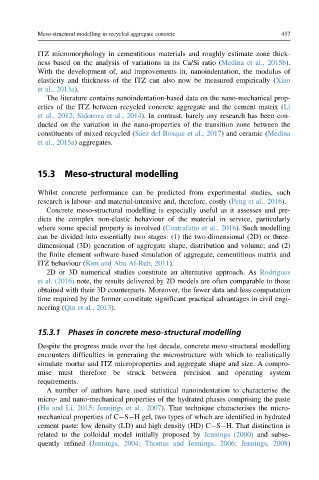Page 507 - New Trends in Eco efficient and Recycled Concrete
P. 507
Meso-structural modelling in recycled aggregate concrete 457
ITZ micromorphology in cementitious materials and roughly estimate zone thick-
ness based on the analysis of variations in its Ca/Si ratio (Medina et al., 2015b).
With the development of, and improvements in, nanoindentation, the modulus of
elasticity and thickness of the ITZ can also now be measured empirically (Xiao
et al., 2013a).
The literature contains nanoindentation-based data on the nano-mechanical prop-
erties of the ITZ between recycled concrete aggregate and the cement matrix (Li
et al., 2012; Sidorova et al., 2014). In contrast, barely any research has been con-
ducted on the variation in the nano-properties of the transition zone between the
constituents of mixed recycled (Sa ´ez del Bosque et al., 2017) and ceramic (Medina
et al., 2015a) aggregates.
15.3 Meso-structural modelling
Whilst concrete performance can be predicted from experimental studies, such
research is labour- and material-intensive and, therefore, costly (Peng et al., 2016).
Concrete meso-structural modelling is especially useful as it assesses and pre-
dicts the complex non-elastic behaviour of the material in service, particularly
where some special property is involved (Contrafatto et al., 2016). Such modelling
can be divided into essentially two stages: (1) the two-dimensional (2D) or three-
dimensional (3D) generation of aggregate shape, distribution and volume; and (2)
the finite element software-based simulation of aggregate, cementitious matrix and
ITZ behaviour (Kim and Abu Al-Rub, 2011).
2D or 3D numerical studies constitute an alternative approach. As Rodrigues
et al. (2016) note, the results delivered by 2D models are often comparable to those
obtained with their 3D counterparts. Moreover, the fewer data and less computation
time required by the former constitute significant practical advantages in civil engi-
neering (Qin et al., 2013).
15.3.1 Phases in concrete meso-structural modelling
Despite the progress made over the last decade, concrete meso-structural modelling
encounters difficulties in generating the microstructure with which to realistically
simulate mortar and ITZ microproperties and aggregate shape and size. A compro-
mise must therefore be struck between precision and operating system
requirements.
A number of authors have used statistical nanoindentation to characterise the
micro- and nano-mechanical properties of the hydrated phases comprising the paste
(Hu and Li, 2015; Jennings et al., 2007). That technique characterises the micro-
mechanical properties of C S H gel, two types of which are identified in hydrated
cement paste: low density (LD) and high density (HD) C S H. That distinction is
related to the colloidal model initially proposed by Jennings (2000) and subse-
quently refined (Jennings, 2004; Thomas and Jennings, 2006; Jennings, 2008)

